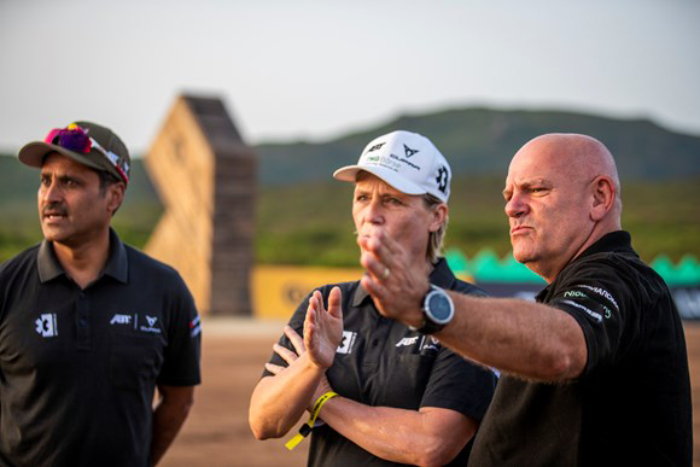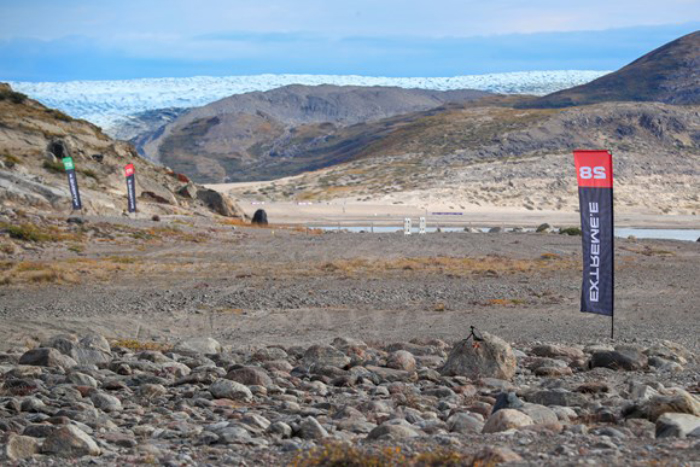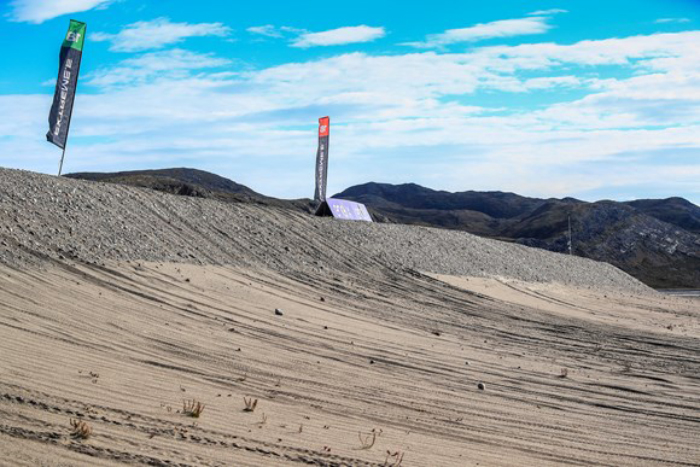Designing an Extreme E course presents extreme challenges. We caught up with Guy Nicholls, Head of Sporting, and Championship Driver Timo Scheider, who has competed for XITE ENERGY Racing this season, to find out how the series’ unique course layouts are created.
Extreme E: Timo, you have a unique role in terms of supporting the design of Extreme E courses. How did that come about?
Timo Scheider: It came about via James [Taylor, Chief Championship Officer]. I met him a couple of years ago via World RX and when Extreme E was beginning to develop. I was a little bit nervous because I hadn’t done anything like this before, however, my knowledge in racing spans more than 30 years so I have seen a lot on-road and off-road.

XE: Once you’ve got the core logistics in place and you have your driving expert ready to go – what’s the next step?
Guy Nicholls: Once we’ve overcome any logistical challenges, then we start on the course recce and design. We spend three days on site driving around to explore every element of that area, and then we begin to formulate an idea for a course. Once you have all the best features in place, such as landscape and backdrop, you can start piecing a layout together. By the end of the three days, you have your course.
We then do a technical recce with our partners Aurora [Media Worldwide], Alkamel, NEP and MRTC to ensure we can get the appropriate technical signals around the course and back to the paddock for our broadcast and communications systems. We spend a good amount of time finalising the details, such as where the cameras should be positioned to capture the action but also to ensure they are in a safe position. We want to get the perfect shots without putting anyone in danger.
Once we have organised the fixed cameras, we then move onto the effects cameras. We might need to change the layout slightly to make sure we can get the effects cameras as near to the course as possible, for instance, which then changes where an apex flag should go. Then, we need to add in the marshal positions at each camera point and around the course.
What we have ended up with in the last 18 months is some pretty great courses and there is a lot of hard work across several different areas of the business to produce them and film them. We all have different things we’re focused on, and it is a real collaborative effort to ensure it all comes together.

XE: What do you look for in particular when designing a course?
TS: I look at it from a driver’s perspective, while Guy looks at the safety side of things as well as how it looks visually. We have to get government approval too, so we to tweak it until everyone is happy across the board.
GN: There is so much to look at as a package – we focus on safety, where marshals will be stationed, and just how the racing might look from a broadcaster perspective. On the course, we try to avoid the holes and rocks, so it isn’t dangerous, and when you put the flags in the ground for the first time, it really changes how you view everything. You’ve got to tweak and adjust again from this, just to make sure it all lines up.
Every single flag is placed specifically for a reason. You put the apex flag exactly where you want them to turn, and you put what we call the redundant flag a good distance away if you want to open the corner up, or you bring it close because there could be something nasty further out – such as a big hole! Moving a flag five metres could mean going from being a corner taken at 20-40kph up to 80kph on exit, so it becomes very different and potentially dangerous, so flag position is crucial.

XE: Have you changed your approach to designing courses as the championship has developed?
GN: We have also brought in Earl Desiderio to help with the layouts of Extreme E courses to really add that further element of excitement and push the drivers to their limits. Earl is an off-road expert from the USA with huge trophy truck, ATV and Dakar Rally experience, so his knowledge of off-road racing is invaluable. Our most recent design in Chile and its characteristics were inspired by Earl’s experiences of off-road courses and featured a number of jumps and steep banked turns. His expertise has brought something totally new and really added to the make-up of our series.
XE: What measures do you take to avoid damaging a landscape?
TS: We always try to minimise what we are doing on site in terms of damaging anything. It is important for us to race without a trace, and this is our overall aim to help and take care of nature on the planet.
Sometimes we design a layout and then we have to make a few changes to that approach, especially if there is a chance that we effect the local habitat. We have to take it all into consideration.
XE: As a driver, what is key to designing an Extreme E course?
TS: When looking at the lap, I am looking for the spectacular – that’s a direct request from Alejandro [Agag]! He would always say “Timo, please make it extreme!”. That’s what I try to achieve in the areas we visit.
It is important to have special features in the lap like a big drop, water splash or a big jump. We need to find places for the ENOWA Hyperdrive and the Continental Traction Challenge too – not to mention plenty of overtaking options with wide lines so it is not just following the driver in front of you. If there is any possibility in terms of space, I always try to give this option for more choice out on track.
If you have a more difficult track, you can then make more of a difference as a driver. If you have a mix of high-speed sections, technical corners, low-speed areas, blind crests and high jumps, the challenge is increased, and you can show your skills and make a difference behind the wheel.

It’s great to see so much risk being taken and how you can make the difference. We create tracks that are different and as a driver you must adapt quickly – which is crucial in Extreme E.
XE: As a course designer, have there been any standout moments for you?
GN: I think Johan [Kristoffersson] passing Laia [Sanz] for the win in Saudi Arabia this year with a couple of corners to go using an alternative line was fairly dramatic – it was exactly what I envisaged when we created the initial course design layout so to see it come to fruition was very rewarding.
The overtake took place towards the end of the lap in NEOM (Saudi Arabia), the drivers would come down a hill and into a tight left-hander. We put the apex flag far enough to the right so the drivers would either have to slow down to keep tight or use the alternate line and come in from a much wider angle. There was a possibility that in doing the latter, you could carry a lot more speed. Johan covered a lot of distance but kept the speed up to be quicker than Laia – it was a great spectacle as a result.

XE: That was a spectacular ending conclusion – are you always in agreement when making the final touches to a layout?
GN: Timo and I had different views on the ending of the course in NEOM! What we ended up with was a steep, spectacular finish to the lap. However, the initial plan was to make it even more daunting over a much higher and steeper drop – more extreme to follow Alejandro’s brief, but the fact was that it would have meant the racing was over before we reached the Finish line, so our final choice proved correct.
It certainly is a team effort though when it comes to designing the tracks in Extreme E. Timo is a two-time DTM Champion and has competed in World RX, so he has plenty of credentials to support the wider team in course development!
XE: Is designing an Extreme E course unique compared to any other racing discipline? Is that where Timo’s background comes in handy?
GN: Because of Timo’s racing history, competing in Rallycross and circuit racing, he really does have a unique blend of expertise. The way we view the courses is rallying meets rallycross meets Dakar meets circuit racing – Timo gives us a terrific blend with his background.

XE: Which course has been the most challenging to design to date?
TS: Greenland was the most challenging as it was so different and had everything in it. We had a rock garden, sand, hills, single tracks, steep jumps, and the dunes. There was high and low speed throughout as well.
It was super tricky to pull off, but it is one of the most exciting tracks we have had. That and the opening race in Al’Ula, Saudi Arabia, are my favourite courses to date.
GN:The same for me – they stand out! Both were around 9km and big courses to put together. Greenland was incredible and a once in a lifetime opportunity and the scenery in Al’Ula was out of this world – there was an epic drop. There were two others, but they were overwhelmed by ‘The Drop’. The shots of the cars coming down that was incredible and a real highlight for the series, especially in what was its first event.
XE: Lastly, what is the relationship like between the three of you?
TS:We get on so well and work collaboratively as a group. I love spending time with the guys and really appreciate their support – it is a great blend of fun and professional. There’s a great energy as we are all working towards a good course… and good cause!

COMMENTS